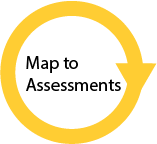Map Activities to Impacts: Logic Models
What is a logic model?
A logic model is a concise way of describing your office or program that shows the path between what goes into your office or program and what comes out of it. Other terms for it include "roap map" or "theory of change", because it explains how your strategy effectively accomplishes your stated goals.
What does a logic model look like?
Logic models are made up of five linked sections, read from right to left or left to right, plus space for stating your goal, context, and assumptions:
| Goal: The purpose of your office or program (see Identify Office or Program Goals). |
| Context: The situation in which the change is taking place: what is the program, what are potential obstacles or opportunities. |
| Assumptions: The assumptions behind the assertion that your strategy will work. |
Resources |
Activities |
Outputs |
Near-Term Impacts |
Long-Term Impacts |
| What you have to work with: people, contracts, infrastructure, etc. | What you will do with these resources. | What evidence will show that activities are performed as planned. | What change will happen as a result of the activities in the near term. | What change will happen as a result of the activities in the long term. |
Why create a logic model?
A logic model is a basic tool that can have all sorts of uses:
- To design a new office or program - to figure out what resources you'll need and what you'll do with them in order to achieve your stated goal.
- To create a management plan for a currently existing office or program - to document what you have and what you need to function effectively.
- To explain to others how your office or program works - to show how resources are used in service of achieving your stated goal.
- To assess the effectiveness of your office or program - to specify the goals, align them with evidence, design measurement schemes and learn from findings.
What makes for a good logic model?
To obtain any of the benefits described above, a logic model must make sense to you and your stakeholders. It should be highly focused on the stated goal (you can always make another logic model for another goal) and use clear, consistent language throughout.
How do I create a good logic model?
- Gather pre-existing materials: As with most assessment tools, you are probably already thinking this way but haven't put it all down in an explicit form. Therefore the best first step is to gather any material you might already have that answers any of the questions in the logic model design: what is the purpose? what do I need to support my activities? what do I expect to come out of it?
- Collaborate across diverse groups: Also as with most assessment tools, logic models are only worth doing if they are useful. The best way to ensure that is to make sure all stakeholders (staff, partners, clients) are part of the creating and/or editing process. You will get the most insight when you draw from people interacting with your office or program in different ways.
- Choose a pathway easiest for you: Finally, you should feel free to approach the diagram from whatever angle seems easiest. Pretty clear on purpose but not how to implement? Start with goals, then move right to left in the diagram from impacts backwards through outputs, activities and resources. Pretty clear on how to implement but not purpose? Start at resources, then move left to right in the diagram through activities, outputs, impacts and then goals. Remember to always keep an open mind as you create - you'll likely be doing a lot of editing in your initial and follow up sessions to get everything just right.
Want examples of good logic models? Visit the Sample Tools page.
You can also find a sample NSF Broader Impacts Evaluation plan here.
![]() Continue to Assess Evidence
Continue to Assess Evidence

